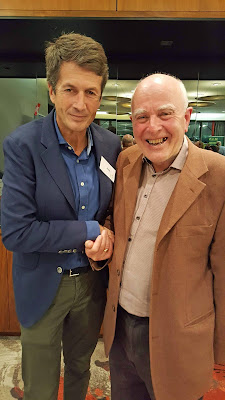O’Briens Wine September Sale In Full Swing
The O’Briens Wine September Sale is in full swing. With about 100 wines reduced you might be in need of some pointers and here are a few of my picks!
Chanson Chablis (AC) 2018, 13%, €16.95 (25.95)
Pale gold is the colour. Aromas are delicate but persistent, citrus fruit, and floral notes too. Fruit flavours are assertive and harmonious and it also boasts the benefit of a fairly rich mouthfeel. A palate full of life plus a refreshing lingering finish. What’s not to like?
It is, of course, one hundred percent Chardonnay, raised on limestone hills south of the village of Chablis. The year had its up and downs before the August harvest was carried out in perfect conditions, grapes ripe and healthy, the wine precise with a beautiful fruit combination.
Food pairing suggested: Pâté, lobsters and poultry as well as some goat cheeses.
O’Briens are enthusiastic: With Chanson's wines now performing at the top level thanks to more than a decade under Bollinger's wing, this Chablis has never been better. … electrifies the palate and has considerable richness for Chablis - ..a real stunner!
* Domaine Chanson dates to 1750 and lies in the heart of Burgundy’s Beaune region. In 1999, the estate was sold to Champagne Bollinger.
Chanson Fleurie (AC) 2018, 13.5%, €16.95 (18.95)
In Beaujolais generally, there is a continuity of quality, almost a guarantee of it, if you move up a step or two to the ten crus and the villages that ring them. Fleurie, like all the crus, is in the north east of the Beaujolais region. Here the Gamay grape thrives on the granite soil, the wines always refreshing and never short of acidity.
Colour of this beauty is a bright mid-ruby. Abundant aromas of cherries and spice. Juicy in the mouth; no shortage of red berries (strawberries, raspberries) and sweet cherry in delicious combination, smooth and well balanced, refreshing too with excellent length. It is, of course, 100% Gamay and no oak has been used by the winemakers.
Did you know that the Gamay grape is an “exile” in Beaujolais? In 1395, it was outlawed by Royal decree, using Trump-like language, as being “a very bad and disloyal plant”. Sixty years later another edict was issued against it. And so it was pushed out of Burgundy and south into neighbouring Beaujolais where it has thrived on the granite based soils.
By the way, the ten crus that produce the flagship wines are: Chiroubles, Saint Amour, Fleurie, Régnié, Brouilly, Cote de Brouilly, Juliénas, Chénas, Morgon and Moulin-à-Vent.
Ortas “Prestige” Rasteau (AOC) 2015, 14.5%, €17.95 (19.95)
Rasteau, about 40 minutes east of the Rhone, sits on a hill in the Vaucluse, one of the five departments of Provence, and the climate is typically Mediterranean (meaning a high level of grape maturity). It is to the north of better known villages such as Gigondas, Vacqueyras and Beaumes de Venise. The village also has the distinction of making fortified wines (vin doux naturel) including a deep coloured red.
I’ve long had a soft spot for Rasteau reds and this dark-red coloured wine keeps me very much onside. Just have to love its rich nose, the red and darker berry flavours, the juice on the velvety palate, a good dash of spice too and those smooth tannins.Terrific balance between wine and wood and a super finish as well.
The grape varieties in this Prestige are the GSM trio (from old vines) of Grenace, Syrah and Mourvedre. Serve at 15 to 16 degrees and you’ll find it goes well with red meats, roast small game and rich cheeses.
Lingenfelder “Bird Label” Riesling 2018, 11.5%, €13.45 (15.45)
The Lingenfelder family, winemakers in the Pfalz area of Germany since 1520, produce this Bird-Label Riesling, one of their "Vineyard Creatures" series that also includes the Hare (Gewürztraminer) and the Fox (Dornfelder) .
Pfalz is in the south west of Germany. It is one of the driest and warmest areas there but still a cool climate. Wines can be more full bodied here in good years. 2018 was warm and dry and some of the 2018 are "not too heavy". All hand-picked, all wild fermented, they rely on the natural yeasts that are all around the cellar. “Authenticity is very important to us,” Georg, the 14th generation of the family in wine, told a Cork audience last year.
This Riesling is off dry and delicious. It has the typical Riesling aromas (citrus-y), is fresh and elegant and may be enjoyed as an aperitif or with light or spicy dishes.

















